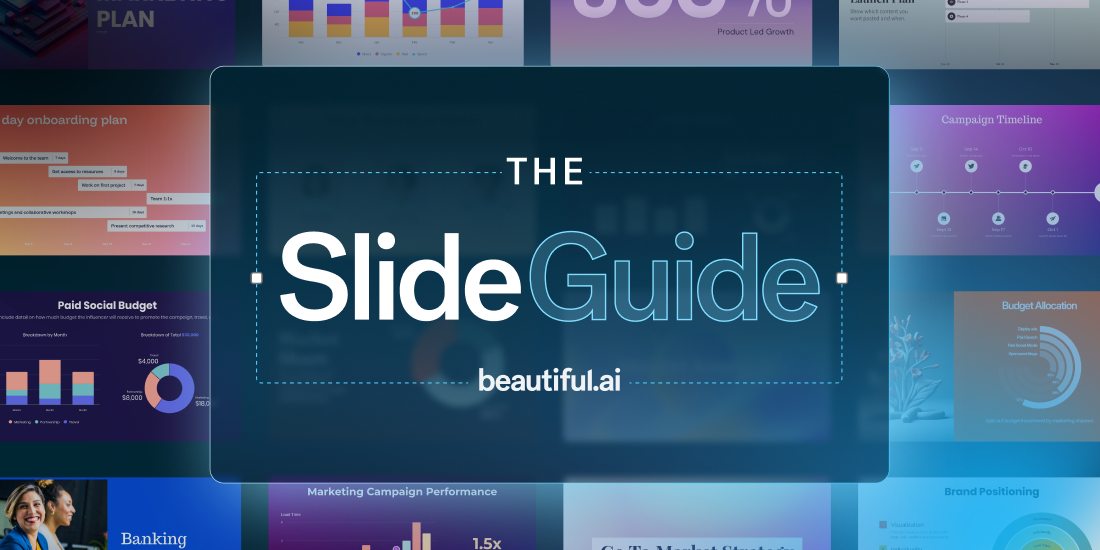
Beautiful.ai is a great tool for compiling sales decks after a demo call with prospective clients, which enables our team to operate quickly. The team templates and shared slide libraries serve as a repository for all of our relevant presentation materials where we can tag and access all things sales. When putting together a deck after a demo, we can easily tap the team template library to grab a sales deck related to the prospective vertical or use case we’re approaching. From there, we use shared slides to pick and choose the best case studies that are relevant to the client. Our team theme keeps our sales managers on brand since it locks our style guide in order to maintain consistency. As an ancillary feature, we’re also able to track the engagement and who is viewing our decks through Beautiful.ai’s analytics functionality— which gives us insight into what content is resonating with the viewer and what needs to be adjusted.
Having a presentation software like Beautiful.ai has helped streamline our presentation design process so the team can focus on the content within the deck that will help them close the deal. When it comes to building out a sales story, there are key components that should be included in each sales deck to position your brand as the answer to the prospects pain point(s).
Structuring a sales deck
During a traditional sales cycle, multiple stakeholders are involved in the buying process and having a deck that can “be your voice” is key. In many cases, a decision maker is not on a demo call so having a deck for them to review may help them pull the trigger.
You may be wondering, how does your sales team control the message? How do you ensure the prospect you shared the demo with can effectively evangelize your product internally?
So what is the structure that wins? Here at beautiful.ai we’ve found that focusing on these key pillars will help your reps control the message across multiple departments:
- Needs Analysis Recap
- Relevant Features/Use Case
- Relevant Case Studies
- ROI
Needs analysis recap
A recap of a needs analysis is critical to showcase that you understand the potential customers’ problems and help them identify why your product is the solution for their issue. It serves as a report of what you discussed on the call and also gives the prospect a voice when evangelizing your product to their internal team and decision makers. The objective is to begin to build a case for why your product is relevant and perfectly aligned with their needs.
Some questions to help your team outline an effective needs analysis slide:
- What issue is the prospective customer facing?
- Quantifying how much time and money they believe they’re losing by not fixing the problem.
- Which departments are feeling the pain the most?
- Feature alignment: highlighting and segmenting the issues that directly align with the solution your product feature provides.
Relevant features
It is important to highlight the discussed features specific to their use case in the sales deck and align them with their needs analysis. This is a way to help the prospect prove out that your product is precisely the solution to match their needs:
- Which features did your team discuss on the call?
- Which product features solve their problem?
Case studies
Case studies are a great tool for showing examples on how their needs analysis is aligned with other customers who have experienced the same challenges and saw your product as a solution. When identifying case studies, sales teams should be focused on case studies that are related to the prospect. Some questions to ask:
- How does the chosen case study relate to the prospects' needs analysis?
- Does the case study align with the targets’ company size and industry?
- Is the outlined use case similar to how they may use your product?
ROI
Finally, spell out the return on investment (ROI) for them. Quantifying ROI is perhaps the most effective way to tie a bow around your messaging and will often help a budget decision maker, who is not an end user, understand how much value your product can add to their organization. Here is an example of Beautiful.ai's ROI presentation slide:
You and your teams should be seeking to understand how you’re uniquely defining ROI for your product and showcase it in a way to prove value around their needs.



.webp)



.png)